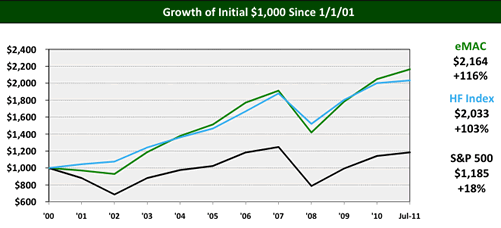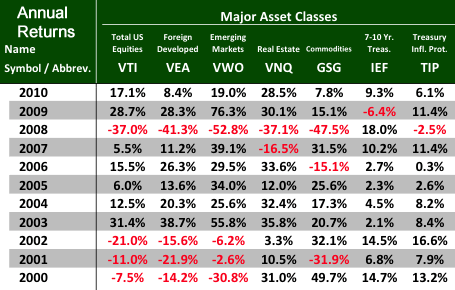Last week, I shared a chart that showed how a diversified portfolio that was rebalanced regularly still managed to nearly double in value over the last decade. Here’s another similar finding based on the David Swensen portfolio as compiled by an advisor group called ETF Portfolio Management.
Swensen manages the Yale University endowment and wrote an excellent investment book called Unconventional Success (my review) directed towards individual investors. Even though he does active management himself, he explains why low costs and low turnover are critical, how certain asset class are better than others, and why rebalancing regularly is important. He ends up providing a model portfolio made up of what he calls “Core” asset classes. Here’s the slightly updated David Swensen Portfolio with his recommended 70% stocks / 30% bonds breakdown. Actual low-cost index ETFs are included via ticker symbols.
30% Domestic US Equity (VTI)
15% Foreign Developed Equity (VEA)
10% Emerging Markets (VWO)
15% Real Estate (VNQ)
15% U.S. Treasury Bonds (IEF)
15% Inflation-Protected Securities (TIP)
Instead of the Total Bond Index from last week, which include everything from Treasuries to corporate bonds to mortgage-backed securities, the Swensen bond allocation only has nominal and inflation-linked Treasury bonds. The chart below shows the growth of $1,000 invested this way (eMAC) at the start of 2001 until the end of July 2011. (Last week’s chart included the start of 2000 to end of 2009.) The ETFs listed above were bought and rebalanced annually. eMAC stands for “efficent multi-asset class”.

Again, we see that the diversified and rebalanced portfolio has done well over the last 10 years, more than doubling in value. Check out their annual returns breakdown (summarized below), and you can see how in any single year different asset classes will have different returns. Some go up, some stay steady, some go down. This lack of strong correlation is what helps smooth out your portfolio, and makes you feel better that at least something is doing okay at any given time.

Now, this may not be the ideal portfolio going forward. Nobody knows the future, you can only do what you think gives you the best odds for success. But it does serve as another real-world example of how low-cost diversification works and that you should have good reasons for holding each of the asset classes that you buy.
(The “HF Index” indicated stands for the Dow Jones Credit Suisse Hedge Fund Index, which claims to track ~8,000 hedge funds and thus tracks overall hedge fund performance. After poking around their website, the returns seem to be net of manager fees.)
 The Best Credit Card Bonus Offers – 2025
The Best Credit Card Bonus Offers – 2025 Big List of Free Stocks from Brokerage Apps
Big List of Free Stocks from Brokerage Apps Best Interest Rates on Cash - 2025
Best Interest Rates on Cash - 2025 Free Credit Scores x 3 + Free Credit Monitoring
Free Credit Scores x 3 + Free Credit Monitoring Best No Fee 0% APR Balance Transfer Offers
Best No Fee 0% APR Balance Transfer Offers Little-Known Cellular Data Plans That Can Save Big Money
Little-Known Cellular Data Plans That Can Save Big Money How To Haggle Your Cable or Direct TV Bill
How To Haggle Your Cable or Direct TV Bill Big List of Free Consumer Data Reports (Credit, Rent, Work)
Big List of Free Consumer Data Reports (Credit, Rent, Work)
I was reading on the Sprint community website regarding the new admin fee increase and a CSR left a comment saying that “it is well under the 1.99 cap per line in the contract agreement which customers agree to when entering into contract with Sprint”
http://www.community.sprint.com/baw/message/325473
How can I dispute that?
Thanks for all your help:)
What if we chart 12-year result (dot-com bubble), or 4-year result (housing bubble) instead? 10-year result has inherently great result for anyone started at the lowest point in the stock market. We can’t time the market as described.
Assuming Vanguard brokerage and intent to invest monthly in these ETFs, are there any good ways to set this up on auto-pilot?
Only option I was able to come up with is to have a monthly reminder and auto-move my money there. But the trades still were “manual”. Any better ideas about set-it and forget-it.
@John Doe – Both of these results include 2000 and 2001 and 2002, which does include the dot-com drop. Look at the annual returns of VTI (US Total Stock Market) during those years. -8%, -11%, -21%. This is not a selective chart, and it includes both the dot-com drop and the credit crisis.
@VBee – You can either use a Vanguard Target Retirement 20XX fund or a service like Betterment for true set-and-forget, but you won’t get all of the asset classes mentioned above. More on Betterment:
https://www.mymoneyblog.com/betterment-com-stock-asset-allocation-updated-2011.html
@Sydney – Perhaps that clause is in some newer contracts, but I would just keep calling in until you get a CSR that will help you. I would say to show me exactly where it says that, because the online contract doesn’t show it. Please post future replies in the Sprint post. Thanks!
Jonathan, you should charge Mr. Swenson commission, as you just sold a copy of his book. I never read him before, but the portfolio I had come up with after reading several other Bogleheadish books the last several years is way closer to his than any sample portfolios from other books.
@Dan – Ha, I do get a commission from Amazon if you bought from there through my link. Fifty-cents, here I come 🙂 But Unconventional Success is definitely one of my favorite books, because it provides a more complete picture of why I invest in certain asset classes other than purely backtested correlations.
Target retirement funds-one of the easier set it and forget it options- still don’t have the advantage of Admiral shares at Vanguard, do you think it’s worth switching over to Admiral for those of us at Vanguard?
Well, if you have enough money to have Admiral funds for all your different asset classes, then in my opinion you can dedicate some time to manage your money, but that’s just me. I’m sure there are folks with a million dollars in a Target fund.
Oh, and I forgot about Folio Investing
https://www.folioinvesting.com/whatfolios/index.jsp
if you really wanted to set up this Swensen portfolio in a set-and-forget manner. You would have to construct a custom “folio” and have them maintain it for you.
Hi Jonathan,
I’ve just found your blog and think your work is great. I’m one of those investors who is tired of watching once “star” mutual funds “run out of gas”. One of the first was Magellan and the most recent was Fairholme. So, I’m looking to move to an ETF allocation model. I agree that the work of Ferri, Swensen and Swedroe is valuable.
I’ve found your 77/23 allocation and that’s about what I use. But I can’t find the specific ETFs (and percentage usages thereof) that you use. Would you be willing to publish this information?
Also, have you published any comparisons of your investment performance to that of Target Date funds with similar allocations? Also, have you published comparisons of how the performance of your asset allocation model has compared to those of Swedroe, Ferri and Swensen? I’d be interested to see if your “tweaks” have added value.
Also, would Marketriders.com be a worthwhile vehicle to monitor the need for rebalancing? I’d be willing to spend the $150/yr to not have to set a spreadsheet up myself.
Finally, do you or readers have any experience with etfpm.com (ETF Portfolio Managers) that you mentioned in an early posting?
Thanks!
Would you give me a similar portfolio in indexed mutual funds as opposed to ETFs?